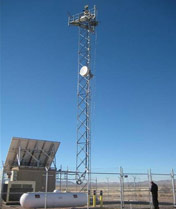DHS begins deploying technology component of its virtual fence
First phase of construction includes a network of 200 ground sensors and a series of towers equipped with cameras and radars on Arizona's border with Mexico.
 The initial rollout of the technology portion of SBINet will include nine towers like the one pictured here.
The initial rollout of the technology portion of SBINet will include nine towers like the one pictured here.
The Homeland Security Department has begun installing a series of networked towers armed with sensors and cameras to monitor a stretch of the U.S.-Mexican border in Arizona, the program's chief said on Friday.
The department started the technology portion of the Secure Border Initiative, known as SBINet, on May 4, said Mark Borkowski, executive director of the massive program.
In its fiscal 2010 budget released on Thursday, the department requested $779 million for SBInet, most of which would go to support the development and deployment of the technology. If Congress fully funds the program, DHS will extend the technology along the remainder of Arizona's border with Mexico by 2011.
"We have [the funds] internally allocated to various pieces of [SBInet] -- additional tactical infrastructure, operational support and maintenance, and continued development of technology," Borkowski said. "Is it enough? Yes. Given our plans, it is enough. Funding affects pace, but funding in 2010 would support our [plans]."
DHS has nearly completed construction on the 670-mile fence along the U.S. southwestern border with Mexico. It has now turned its attention to building the technology portion of the SBInet program. In the initial roll out, known as Tucson-1, the department plans to install 200 ground sensors and build nine towers, which will be equipped with day- and night-time cameras and radars to detect and identify movement along the border.
That equipment will be connected to eight microwave relay towers that can transmit images to a command-and-control system known as the Common Operating Picture. The system will collect and integrate the data from all the equipment to give border agents a multifaceted view of what is occurring along the border.
Before deploying the technology, DHS tested the system and uncovered numerous technical problems. For example, the department intended to use satellites to send signals from towers to stations, but the transmission was too slow. Microwave communications proved more effective.
"We've been working over the past months to close out issues," Borkowski said. "I'm not going to swear this system will work, because I haven't turned it over to the operators, but in terms of what a reasonable engineer can do, we're OK."
DHS cannot install sensors on towers until it verifies all problems have been solved, a process that Borkowski said could be completed within the next two weeks. By summer, he expects the technology will be ready for more tests to "confirm we built what we thought we were building." Once those are complete, Border Patrol agents will do a formal operational test in December.
Also this summer, Homeland Security plans to deploy the system to a second region in Arizona it calls Ajo-1, which will test the equipment in a different environment. Located south of Ajo, Ariz., this project will cover an area of about 30 miles that is flanked by a national wildlife refuge on the west side and an American Indian reservation on the east.
The future of SBINet depends on the success of these initial projects, according to Borkowski. "What we learn becomes input for a department decision on whether we will deploy to the rest of Arizona," which could occur next year, he said.
To support agents patrolling the U.S.-Canada border, DHS awarded a $20 million contract to Boeing Co. in March to develop video surveillance systems in Buffalo, N.Y., and Detroit. The systems will be evaluated next year. An additional $40 million was set aside in 2009 for applications that integrate surveillance video with data taken from sensors that support northern border security, such as the Customs and Border Patrol air and marine forces, and state and local law enforcement.
NEXT STORY: The Budget: A 'Scintillating' Read


